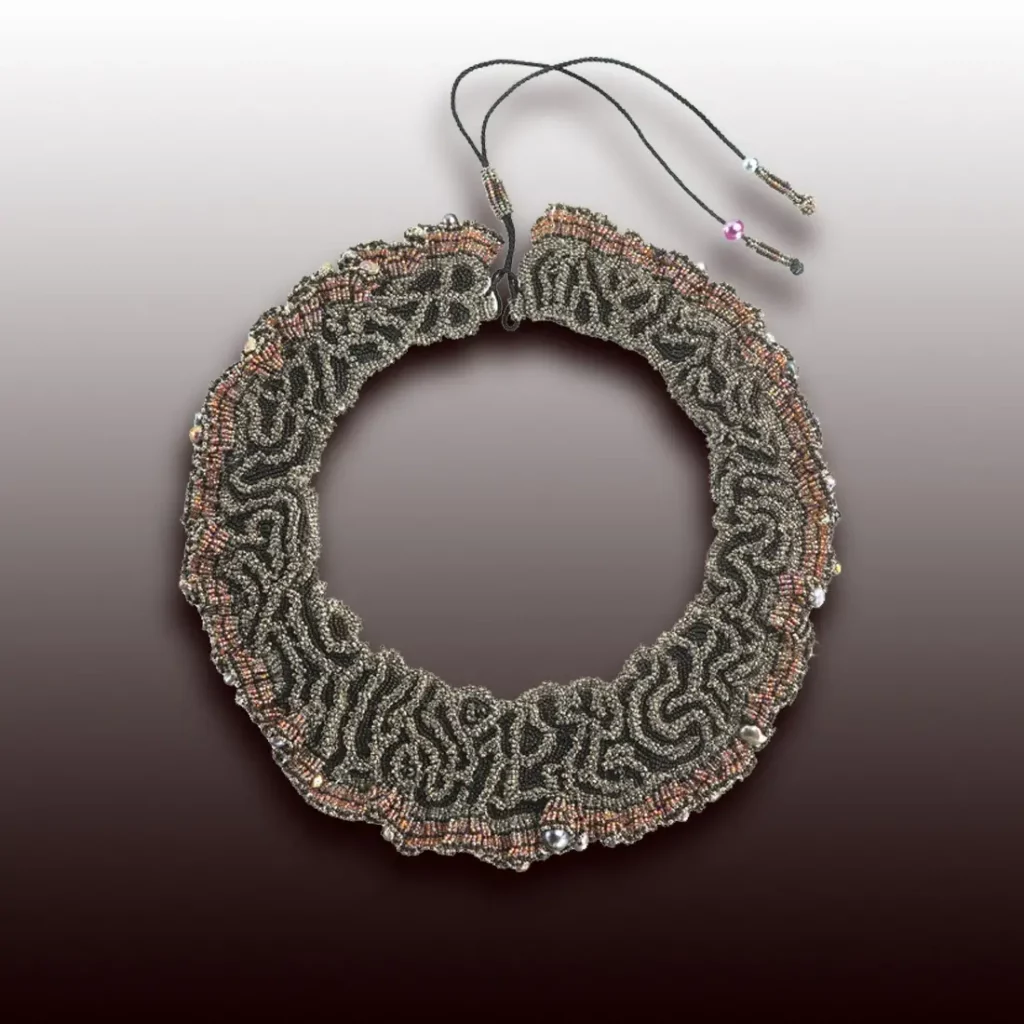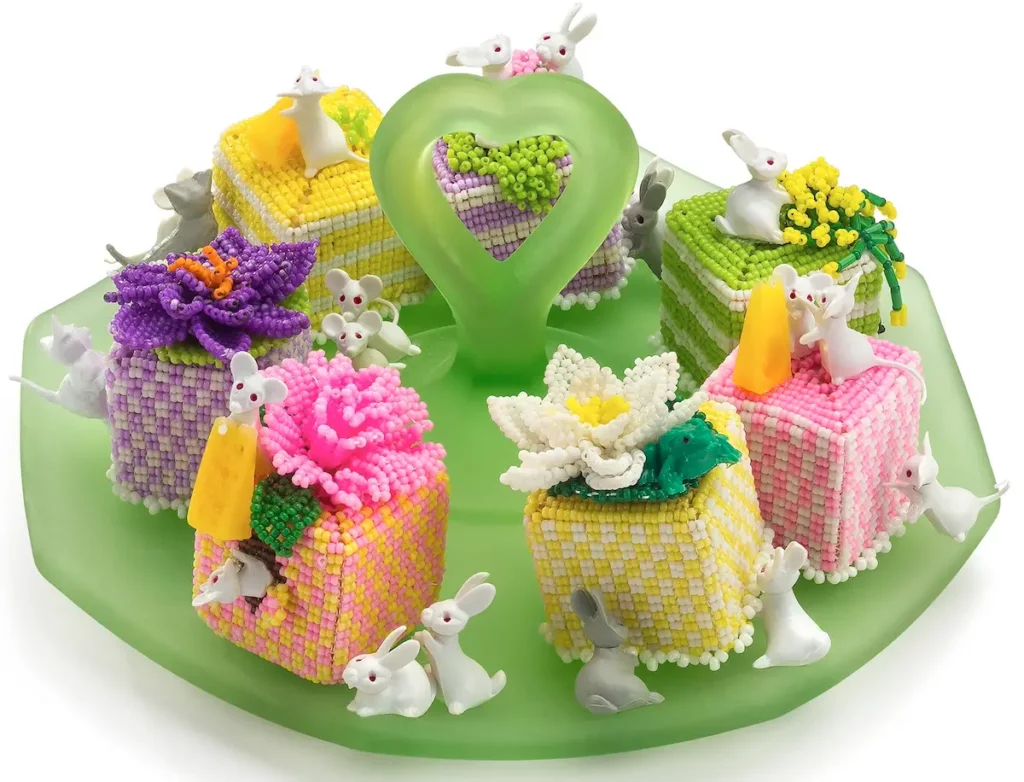Linda Rettich found her artistic calling in beading, a medium she initially didn’t expect to embrace. She creates intricate pieces with small seed beads, allowing her to feature rich details in her art. For Linda beading is a meditative process that clears her mind and fuels her creativity.

Why beading? How does that medium best express what you want to communicate through your art?
After my career in graphic design finding graphic solutions to commercial design problems, I now create work based on my own concepts and time line.
After exploring many different fiber media and techniques, I settled on beadwork. It was the last craft form I thought I’d be interested in. After a friend showed me a few techniques and after several workshops I was hooked!
I like a challenging project. I work with tiny size 15 seed beads so I can get more detail into my work.
As an Amazon Associate I earn from qualifying purchases. Read more about our affiliate linking policy.
Many people have expressed that I must have great patience to work this way. I happen to find it meditative. It clears my head of the day-to-day nonsense and allows me the pure pleasure of the process.
When I am in this meditative zone, I come up with all sorts of creative ideas whether for my beadwork or solutions for other aspects of my life. I love the fact that I can do this portable work anywhere.
I enjoy that I can tailor the process to my current mood, doing relaxing repetitive work which is meditative on one hand, and on the other challenging myself with problem-solving. And, I love taking techniques from one type of fiber arts and incorporating it in my beadwork.
What other media do you use in your work?
I have tried quilting, Sashiko embroidery (which I happen to enjoy for the same reasons I like beading), other forms of embroidery and mixed media. I also like that I can incorporate small fiber pieces that I have picked up on my textile tours to India, Japan, and Peru and incorporate them into my projects. I think of it as a fiber collage. Using these wonderful works is much better than storing them in a drawer.
In my Fairy Tale series, I used a porcelain doll from my doll collection. I beaded the doll’s costume, hair, hat, and shoes. Plus I made a Sashiko duvet cover, which is on the top of the bed, and a miniature yo-yo quilt. The other fabrics come from my collection of ethnic textiles purchased on various tours.

Do you do series work? How does that affect your approach?
Yes. After creating the first piece in a series, I find that I have come up with new ideas to push the series forward. It’s an adventure trying to see how far I can go with one basic idea. I consider new techniques or approaches from other art forms and cultures. Occasionally I have a one-woman show of my work.
In my Collar Series, I considered beading as a form of textile work, using off-loom bead weaving, sewing, and more.
On my first collar, I did a simple graphic design that plays with color.

The next collar represents ombre textiles. I have also tried clan tartan plaids and African kente cloth designs for collar designs

For a change of pace, I tried creating chenille used in another series.
I then went back to my collars to see if I could bring other textile techniques into my beadwork. I wanted to create some dimension and decided that smocking would do that. The smocking idea came to me when I saw a little omiyage (small Japanese gift) out of fabric. I liked the fact that they used a simple quilt pattern and smocked it.

I then envisioned that I could create a larger version of the omiyage for a shoulder bag.
My next endeavor was to try smocking on one of my collars. I was delighted to find that when I smocked my beadwork, I wound up with two different patterns, one for each side of the necklace. It’s reversible!


I did several collars in this technique and I gifted a Black and White one to Ruth Bader Ginsberg.
Since I am very interested in African textiles, I took a kente cloth beaded the design, and smocked it. It is the final piece in this series. It is my favorite and it won several awards in juried shows. To get the effect I wanted, I had to make a 12-foot strip of beadwork When that strip was finished I smocked it down to a size that fit around my neck. I did add some red round disks to one side.

After the smocked series of collars, I decided to do a themed series. Below are two based on my Sea Life.

I developed a technique so that I could work flat on the Sea Fan Collar, a free-form beaded piece. Free-form beadwork can be rather drapey. I found a way to work it flat. I used antique seed beads and pearls to bring this piece to life.

While working on the Brain Coral Collar, I developed a technique so I could create dimension by beading up from the beaded base. In this piece, I used seed beads and antique steel-cut beads.
What do you do differently? What is your signature that makes your work stand out as yours?
I approach my beadwork from the textile point of view, creating new techniques to solve beading problems, incorporating techniques from other media and inspiration from ethnic textiles. Not only do I create original jewelry with these techniques, I also create elaborate dioramas.

Where do you find your inspiration for your designs?
I find inspiration from all over the world. For a long time, I was in love with Ukiyo-e woodblock prints. I did quite a lot of printmaking in my earlier years. I was one of several members who founded the Ukiyo-e Society of America which then grew into the Japanese Society of America which covers many Japanese art forms.
I am a graduate of Pratt Institute where I studied printmaking, painting, drawing and typography amongst other subjects. Much of this background inspires my work. And, I love ethnic textiles.

When it comes to creating, are you more of a planner or an improviser?
I have zillions of ideas in my head and a list of possible beadwork projects. When one really grabs my attention and hangs around in my mind, I begin to plan for that project.
My projects start with a general idea. Then I do some research on the subject. Next, I assemble all of the materials I’ll need for the piece. I do not put anything down on paper, I just dive in.
As I work, different approaches to the project come to mind and I might choose to use one. From then on it’s a beading adventure!
My finished pieces frequently wind up being quite different than my original concept.
I find that I do some creative problem solving in my sleep. If I think about a problem before I go to sleep, I often wake up with a solution.

Describe your creative space.
I never have enough space! I have a 3 bedroom apartment and 2 of the bedrooms are studio spaces. Storing my art supplies require a great deal of space. I have Ikea cabinets up to the ceiling in both rooms. It tends to get quite messy.
At the beginning of a project, I pull out all sorts of materials and audition them. At the end of a project I should clean up immediately, but I don’t. When I walk past these spaces I find that I’d prefer to take a nap.
Eventually, it all has to be cleaned up and organized so I can start a new project with a clean desk.

How often do you start a new project? Do you work actively on more than one project at a time?
I start new projects when I just can’t stand waiting to finish a current one. That’s why I usually have about 10 projects available to me to work on.
When I get stuck on one, I pick up another. Some projects I actively work on, and some require some time to marinate. It’s helpful to have several projects going at a time. Sometimes I find one project might inform another.


Can you tell us about the inspiration and process of one of your works?
I described my collar series above. One thing that I didn’t mention was how I got into creating dioramas. It started with a piece of clan tartan that was left over from my smocked collar series. Someone had given me an articulated wooden doll. It happened to be on my desk next to this scrap piece. When I picked up the beaded tartan, I suddenly got the idea of creating a kilt for that doll. Thus my dioramas were launched.


Since I am a foodie, I did a series on food. Unfortunately, it began to get too fattening: I loved eating the samples. When I started a diet, I abandoned my cannoli project.



How does a new work come about?
It comes about in many ways. Sometimes as I’m working on a piece new thoughts for a series come to mind, such as the clan tartans. Sometimes I see something inspiring, and sometimes I respond to a challenge.

Which part of the design process is your favorite? Which part is a challenge for you?
I enjoy both the meditative process of repetitive work and the more challenging process of problem-solving.
Finishing the non-beadwork aspects of a diorama is the most difficult. That stage usually requires me to often work outside of my areas of expertise such as constructing props or finding interesting ways to display a piece.

How has your work changed over time?
I started making jewelry, and at some point, I found that a leftover piece of smocked plaid beadwork would make a great kilt for a doll on my desk. I then began to use other textile techniques in my projects and began to do some mixed media work. I have no idea where I will go next, I’ll just let my work evolve naturally.
Below is a diorama from my Family Series: Rose and Daughters. It’s a less formal diorama based on a formal family portrait of my grandmother and her 4 daughters that is on the easel.


Learn more about Linda and her work on Instagram.
Interview posted November 2023
Browse through more bead inspiration on Create Whimsy. Learn how to do off-loom bead weaving.

